Introduction
Small and Medium Enterprises (SMEs) significantly contribute to the economic growth in both developed and developing countries. To promote their progress, SMEs focus on entrepreneurial marketing among other modern marketing tools (Arend 2014; Lahtinen 2013; Lawrence et al. 2006; Sharma 2011).
Entrepreneurial marketing is important for SMEs because:
- it focuses on exploitation of opportunities and adopts innovative approaches to attract customers and to increase profitability (Morris, Schindehutte & LaForge 2002);
- it can influence SMEs’ sustainability (Morrish 2011; Rezvani & Khazaei 2013).
Sustainability concept dictates that an entrepreneurial entity should have the capacity of meeting the present needs of the current generation without compromising the ability of future generations to meet their own needs (Masurel 2007; Starik & Kanashiro 2013).
Achieving sustainability, SMEs:
- engage in the environmental activities that help a business to utilise market opportunities;
- concentrate on creating the value for the society;
- implement effective strategies to increase profits (Lawrence et al. 2006; Parrish 2010; Tambunan 2008).
In both developed and developing countries, SMEs:
- play a major role in economic development and ensuring sustainability as they have been the central source of employment generation and output growth (Kongolo 2010; Simpson et al. 2004; Tambunan 2008);
- employ higher percentage of citizens as compared to large corporations and government agencies and represent the highest percentage of all enterprises (Stefanović et al. 2010; OECD 2009).
In Saudi Arabia:
- SMEs represent 92% of all registered business units (Alsaleh 2012);
- 80% of the country’s workforce comes from SMEs (Alsaleh 2012);
- SMEs’ contribution to the GDP is around 33% (Alsaleh 2012; Riyadh Camber Commerce & Industry 2011).
SMEs have attracted the attention of researchers and stakeholders to discussing how firms can become successful in terms of sustainability (Ahrholdt 2011; Allurentis Limited 2013; Alsaleh 2012; Ramachandran et al. 2006).
- most of SMEs fail soon after starting operations because of an issue of sustainability (Gladwin 2010);
- the average life span of SMEs is only seven years (Ahrholdt 2011; Allurentis Limited 2013; Alsaleh 2012; Ramachandran et al. 2006);
- the contribution of SMEs to the country’s GDP is minimal (Alsaleh 2012; Nasr & Rostom 2013; Sadi & Iftikhar 2011);
in contrast, SMEs are one of the leading contributors to the GDP in the United States and United Kingdom (Gilmore, Carson & Grant 2001; Hall, Daneke & Lenox 2010).
Challenges in SMEs are lack of future planning, absence of innovation, managerial skills, financial support, marketing knowledge and competencies or human resources capabilities (Alsaleh 2012; Dyer & Ross 2008).
Entrepreneurial marketing is important to address challenges because of the relationships between the dimensions of entrepreneurial marketing and business sustainability (Franco et al. 2014; Hacioglu et al. 2012).
To support SMEs in Saudi Arabia:
- The Saudi Industrial Development Fund (SIDF) established a “kafala” fund to provide financial assistance to Saudi SMEs (Alsaleh 2012).
- The Saudi Credit Bank provided social loans to low-income individuals to help them with starting their businesses (Hertorg 2010; Sivakumar & Sarkar 2012).
- Private agencies executed support programs for SMEs in the Gulf region to gain external resources through learning and sharing (Hertorg 2010; Sivakumar & Sarkar 2012).
- Still, the policies aimed to support SMEs in Saudi Arabia are rather ineffective because they avoid focusing on sustainable factors (Alsaleh 2012; Masurel 2007; Saudi-US Relation Information Service 2011; Shalaby 2004, 2010).
More researches are needed to examine positive effects of entrepreneurial marketing on SMEs’ performance and sustainability in Saudi Arabia (Hall et al. 2010; Morris et al. 2002).
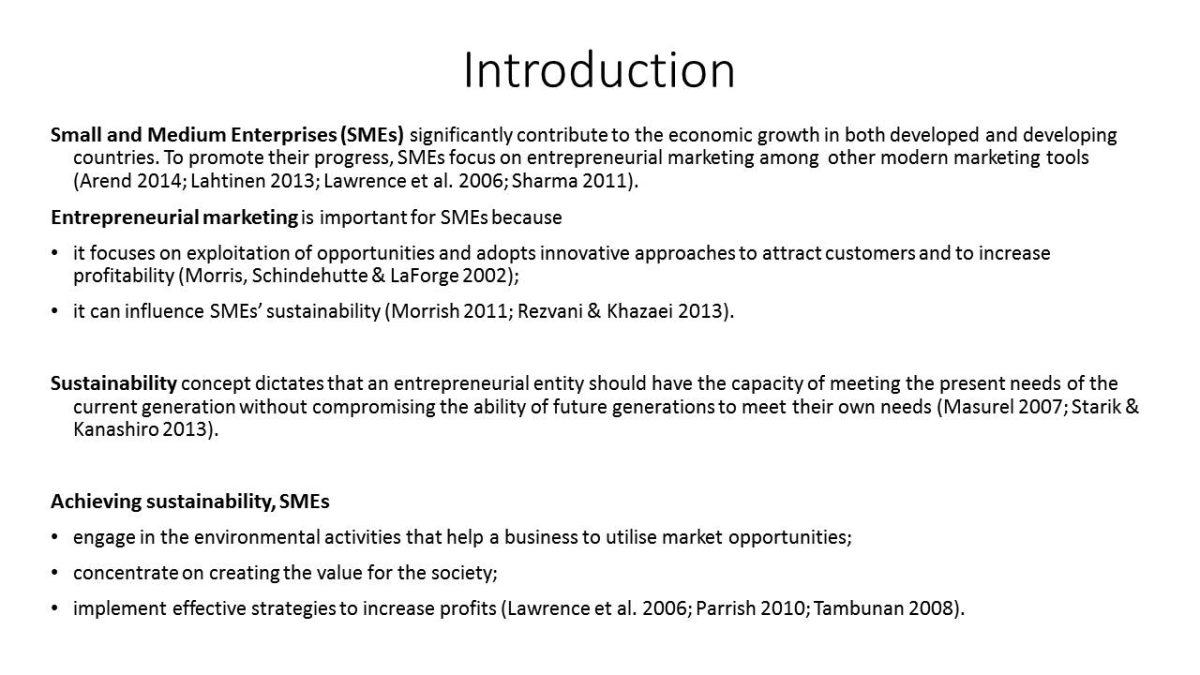
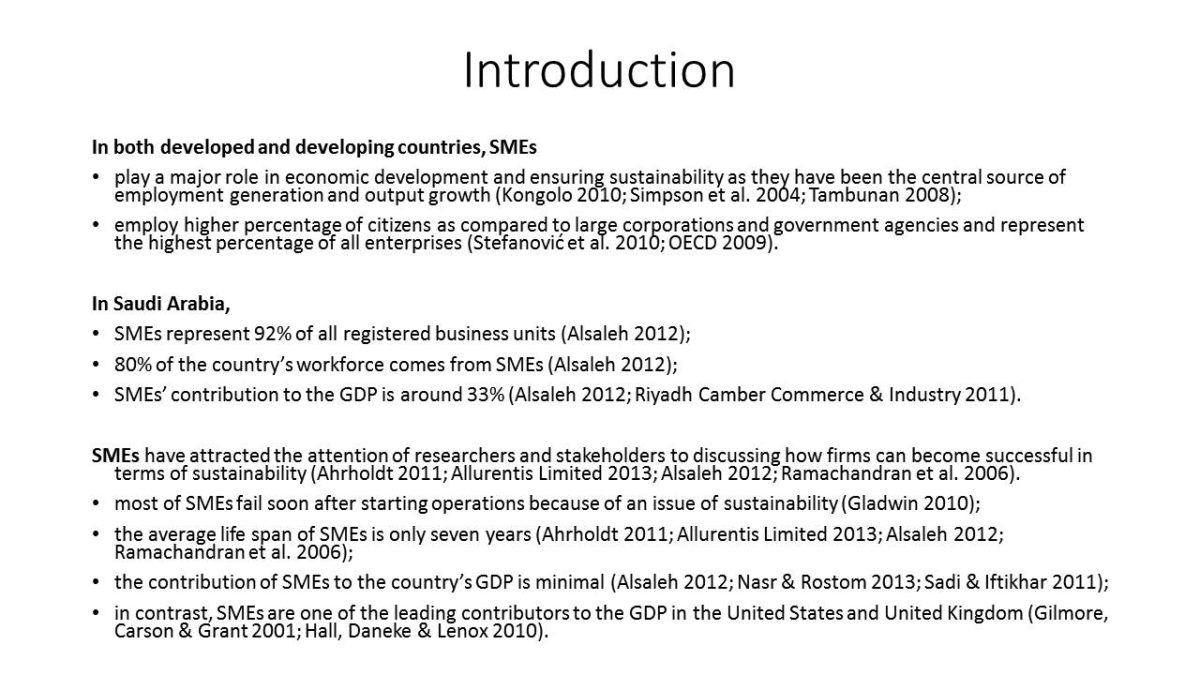
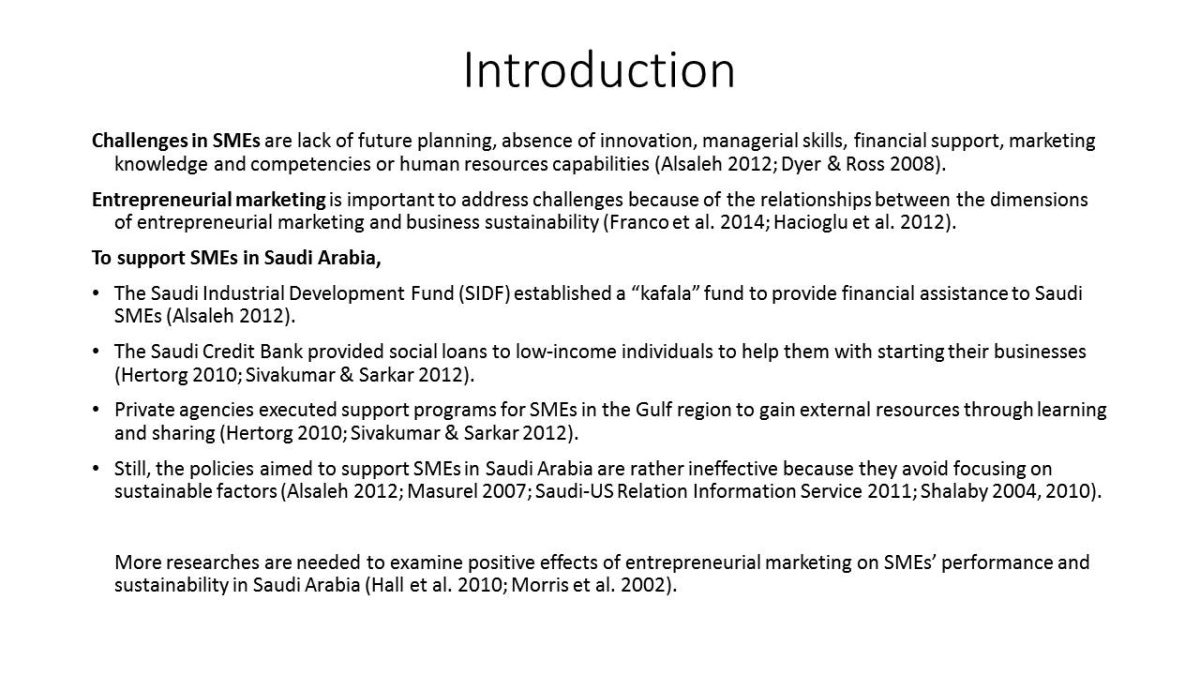
Problem Statements
- Developing countries have unpredictable market conditions, and there is little chance for SMEs to become successful during first two critical years after startup (Kesper 2001; Moore & Manring 2009; Müller & Pfleger 2014).
- In many SMEs, owners fail to meet the majority of goals and objectives, and managers are under the increasing pressure of the issue of sustainability (Asif et al. 2011; Moore & Manring 2009).
- SMEs need to achieve the competitive advantage in order to promote sustainability practices through finding specific resources and strategies (Amoah-Manseh 2013; Loucks et al. 2010; OECD 2009; Sull & Escobari 2004).
- SMEs in Saudi Arabia last only about seven years because of the inability to achieve sustainability as a result of problems with funding, high cost of capital, restriction of financial application, lack of managerial and marketing capabilities (Al-Jasser 2011; Alsaleh 2012; Hertorg 2010; Nasr & Rostom 2013; Rocha et al. 2011; Sadi & Iftikhar 2011).
- About 78% of SMEs in Saudi Arabia have problems with marketing, and entrepreneurial marketing in particular (Al-Jasser 2011; Alsamari et al. 2013; Berghman et al. 2013; Saudi-US Relation Information Service 2011; Shalaby 2010).
- SMEs experience challenges and financial constraints, and they need entrepreneurial marketing tools to gain benefits and attract stakeholders with the focus on innovative techniques and competitive strategies (Gaweł 2012; Kurgun et al. 2011; Müller & Pfleger 2014).
- Entrepreneurial marketing dimensions such as proactiveness, innovativeness and resources leveraging can be associated with enhancing business sustainability in companies (Hacioglu et al. 2012; Kurgun et al. 2011).
- Value creation and customer intensity might relate to proactiveness, innovativeness, and resource leveraging, but there is a lack of empirical studies (Gaweł 2012; Hacioglu et al. 2012; Kurgun et al. 2011).
- The existing studies are fragmented because they are focused either on sustainability, the progress of SMEs, or on the elements of entrepreneurial marketing (Hacioglu et al. 2012; Hills & Hultman 2011).
- It is necessary to research to what extent entrepreneurial marketing influence SME sustainability and how dimensions of entrepreneurial marketing can relate to each other.
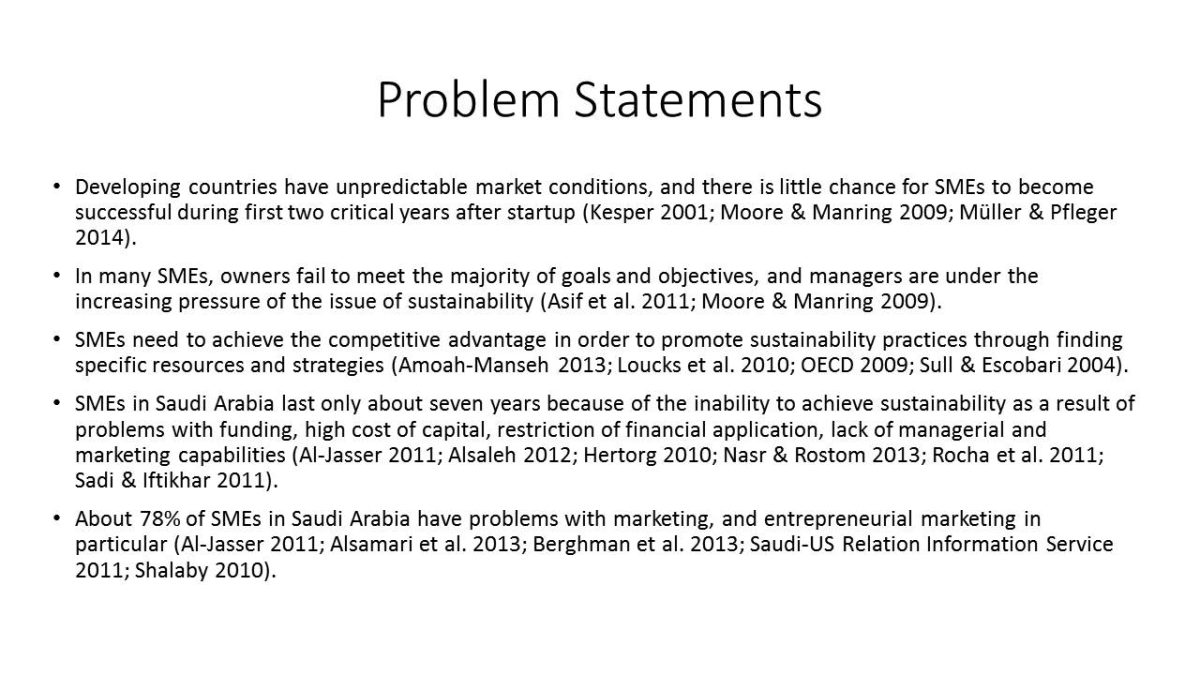
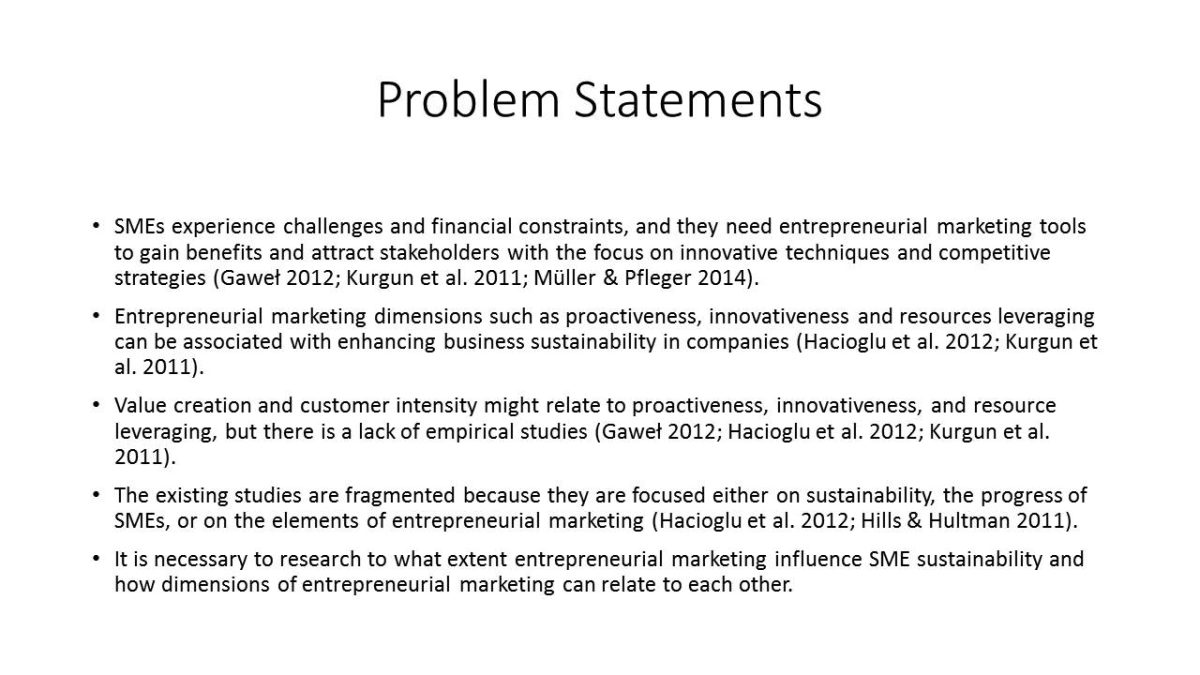
Research Questions
General Research Question
The general research question for this research is:
Whether entrepreneurial marketing dimensions have significant effect on SMEs’ business sustainability, and what are the likely inter-relationships between the dimensions of entrepreneurial marketing?
The Specific Research Questions
- To what extent proactiveness, innovativeness and resource leveraging as dimensions of entrepreneurial marketing affect SMEs’ business sustainability?
- To what extent value creation and customer intensity have effects on SMEs’ proactiveness?
- To what extent value creation and customer intensity have effects on SMEs’ innovativeness?
- To what extent value creation and customer intensity have effects on SMEs’ resource leveraging?

Research Objectives
General Research Objective
The general objective of this research is to examine the effect of entrepreneurial marketing on SMEs’ business sustainability and to examine the inter-relationships between the dimensions of entrepreneurial marketing.
Specifically, this research aimed to achieve following objectives
- To examine to the predictive effect of proactiveness, innovativeness, and resource leveraging on SMEs’ business sustainability.
- To examine the predictive effect of value creation and customer intensity on SMEs’ proactiveness.
- To examine the predictive effect of value creation and customer intensity on SMEs’ innovativeness.
- To examine the predictive effect of value creation and customer intensity on SMEs’ resource leveraging.

Contribution of the Study
Theoretical Contribution
- This study will add to the existing knowledge on the relationship between entrepreneurial marketing and sustainable development by examining the relationship between value creation, customer intensity, proactiveness, innovativeness, resource leveraging and SMEs’ business sustainability.
- The inter-relationships between the entrepreneurial marketing dimensions will be empirically tested for the very first time to address the need for information in the sphere (Morris et al. 2002).
- The study will enrich the existing knowledge while examining specific key entrepreneurial marketing dimensions that affect sustainability of SMEs and providing empirical evidence by validating a model of sustainability in SMEs.
Managerial Contribution
- Providing the useful practical information on the effect of entrepreneurial marketing dimensions on SMEs’ business sustainability, the study will address the lack of sufficient knowledge of the best practices in the field.
- Referring to the information, SMEs will be able to structure their limited resources to influence business sustainability.
- Entrepreneurs will be able to indicate which entrepreneurial marketing dimensions can be helpful to achieve the sustainable advantage in their operations.
- The practical advice will be provided to SMEs’ business executives on the importance of hiring skilled employees who understand marketing dynamics and its role for achieving sustainability.
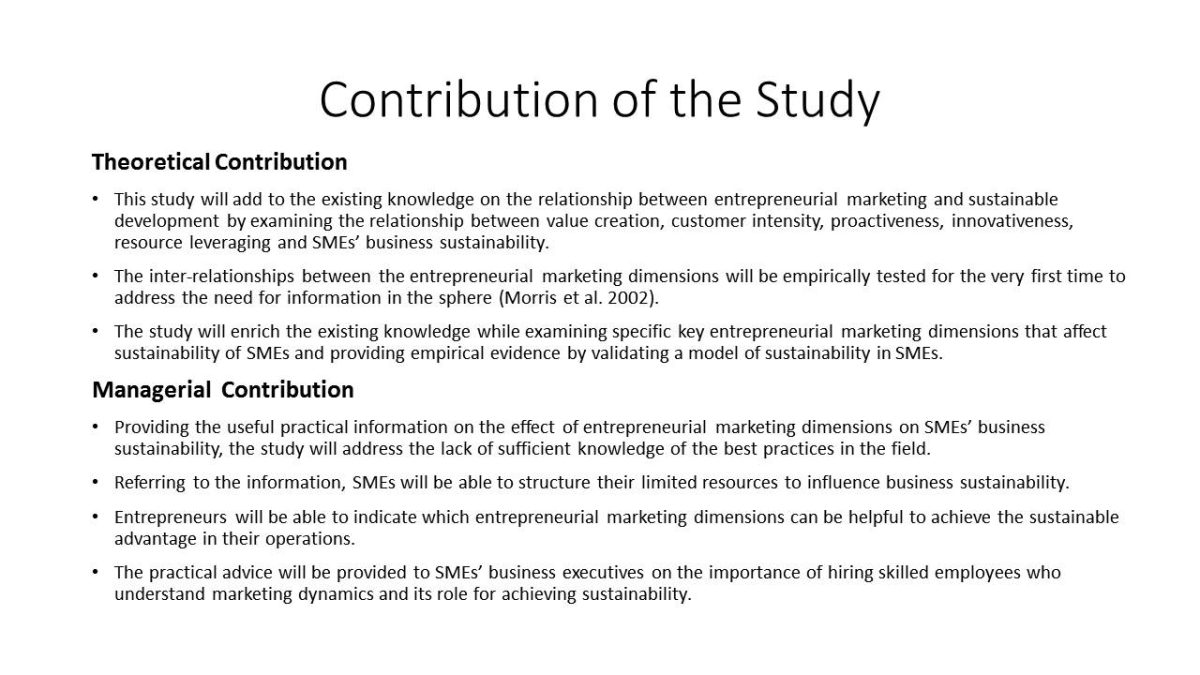
Literature Review
Sustainability Roots
Institutional Theory (1980s) states that regulatory structures, social institutions, and the government influence organisations, and they need to conform to the rules in order to develop and succeed (Brunton & Ahlstrom, 2010; DiMaggio & Powell 1983; Meyer & Scott 1983; Rivera 2004; Webb et al. 2011). Institutional Theory creates the framework for the research because it explains how changes in social environments can influence the sustainable practices (Delmas 2002; Glover et al. 2014; Wu, Ding & Chen 2012).
Contingency Theory (1960s) focuses on measuring a range of contingencies influential for building sustainability (Burns & Stalker 1961; Lawrence & Lorsch 1967). These contingencies are the size of a business, uncertainty of the environment along with environmental issues, the development of technology, and risks (Buttermann, Germaina & Iyer 2008; Ketokivi 2006).
Sustainability Concept
- Sustainability is mainly viewed from environmental and social dimensions, and sustainable development helps in meeting the current needs in a way that does not compromise future generation’s ability to complete their needs (Avram & Kuhne 2008; Brilius 2010; McAdam 2000; Moore & Manring 2009).
Three Pillars of Sustainability:
- people (social pillar), profit (economic pillar), and planet (environmental pillar) (Brilius 2010; Theyel & Hofmann 2012; Welcomer 2011).
SMEs’ Sustainability
- Sustainability practices enable SMEs to meet their obligations towards stakeholders by embracing economic, social, and environmental spheres (Han et al. 2014; Moore & Manring 2009).
Conceptualisation of Entrepreneurial Marketing
- The conceptualisation of Entrepreneurial Marketing is a complex process that is based on identifying aspects of the effective marketing and practices typical for successful entrepreneurs.
- The concept of Entrepreneurial Marketing was proposed only thirty years ago, and conceptualisation of Entrepreneurial Marketing is associated with determining the components of the business success (Becherer et al. 2008; Kraus et al. 2010).
- The Entrepreneurial Marketing concept lies between marketing and entrepreneurship fields, and it opposes the basic principles of these fields (Ionita 2012; Morris et al. 2002).
- Entrepreneurial Marketing is a marketing strategy that uses innovation, proactiveness, and risk taking initiatives to make use of limited resources within a firm to create awareness of the firm’s brand and products within the market (Morris et al. 2002).
- SMEs with limited resources utilise EM to compete in specific industries with the aim of achieving competitive advantage by increasing the customer value (Hills et al. 2008; Kurgun et al. 2011).
Entrepreneurial Marketing Dimensions
- Proactiveness: A person’s behaviour that has the potential to bring about the change and exploit the opportunity to obtain maximal financial benefits (Gaweł 2012; Rezvani & Khazaei 2013). Proactive entrepreneurs create new products and a market for them while gathering information from customers and fellow competitors on unarticulated and unmet needs of the population (Morris et al. 2002; Rezvani & Khazaei 2013).
- Innovativeness: Innovativeness depends on a search for creative, unique, and new solutions to meet customer needs or solve problems (Morris et al. 2002; Rezvani & Khazaei 2013). Innovativeness as the use of the technological progress and experimentation to influence the improvement of products and processes enables SMEs to gain and maintain the competitive advantage (Gaweł 2012; Harrigan et al. 2011; Morrish 2011; Theyel & Hofmann 2012).
- Value Creation: A process of finding new sources in order to contribute to the existing value. Thus, the value creation depends on a choice of unique combinations of resources to gain profits (Gaweł, 2012; Morris et al. 2002; Rezvani & Khazaei 2013).
- Resource Leveraging: The ability to optimally utilise what is available to develop a market base, advocates for doing more with less. The focus is on recognising resources effectively and on their choice to achieve the maximum (Morris et al. 2002; Rezvani & Khazaei 2013).
- Customer Intensity: A dimension that explains an entrepreneur’s efforts to attract and retain clients as well as the focus on customer-centric relationships (Morris et al. 2002; Rezvani & Khazaei 2013).
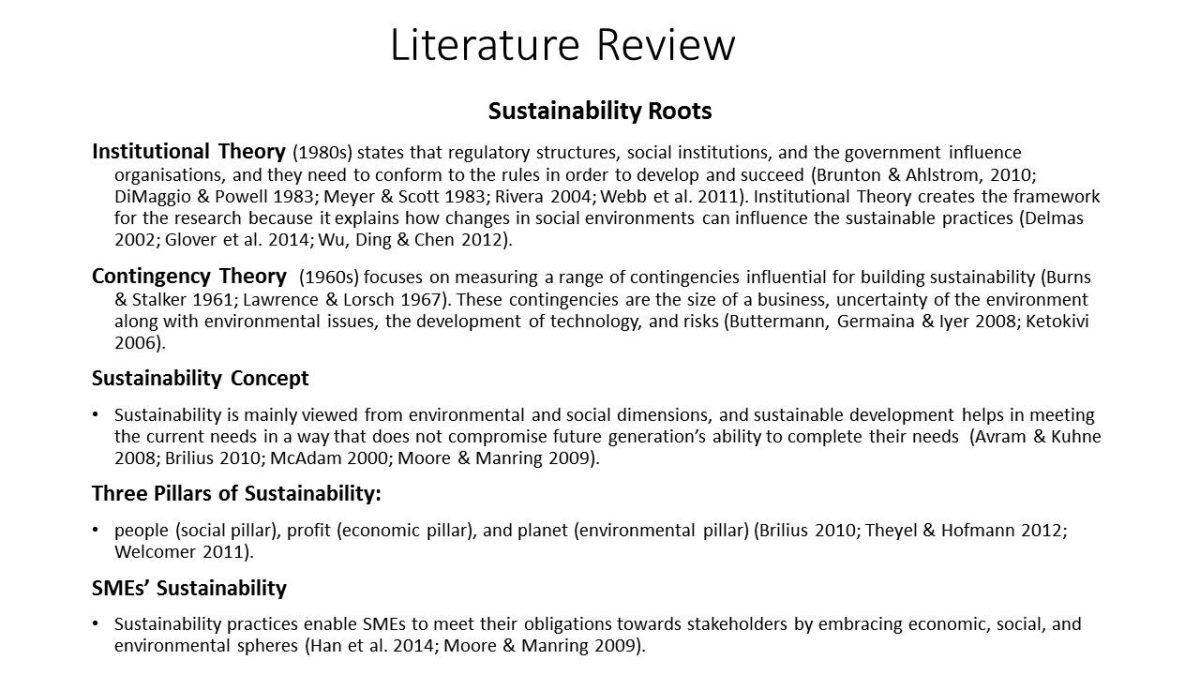
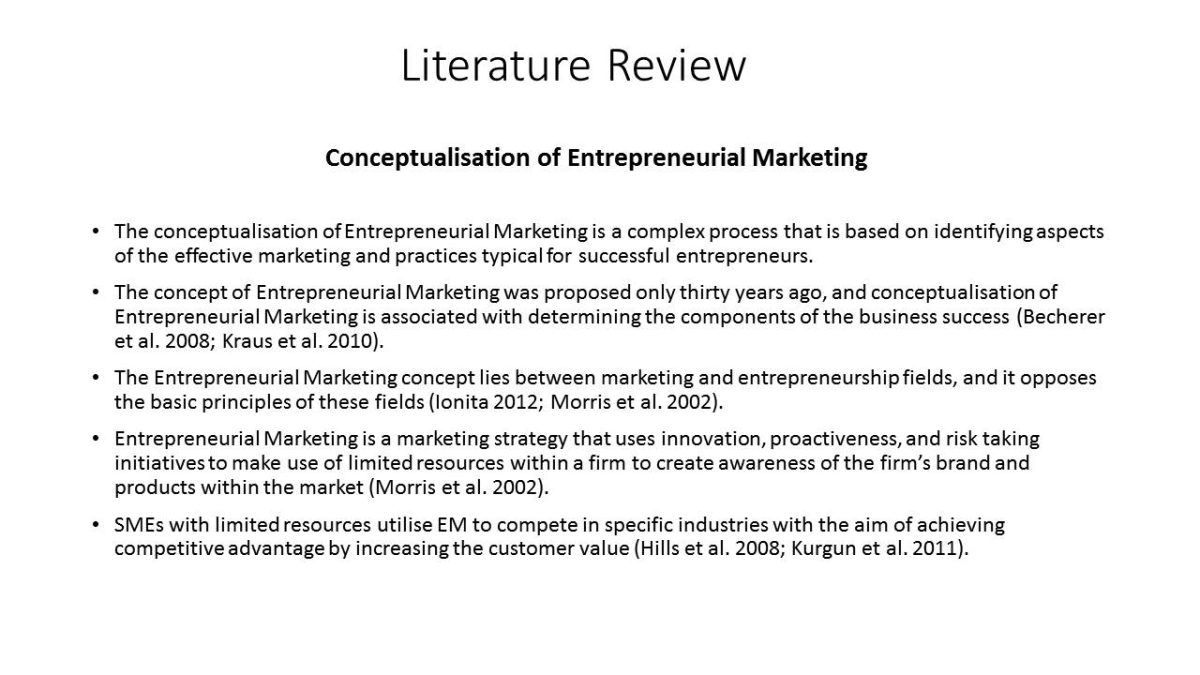
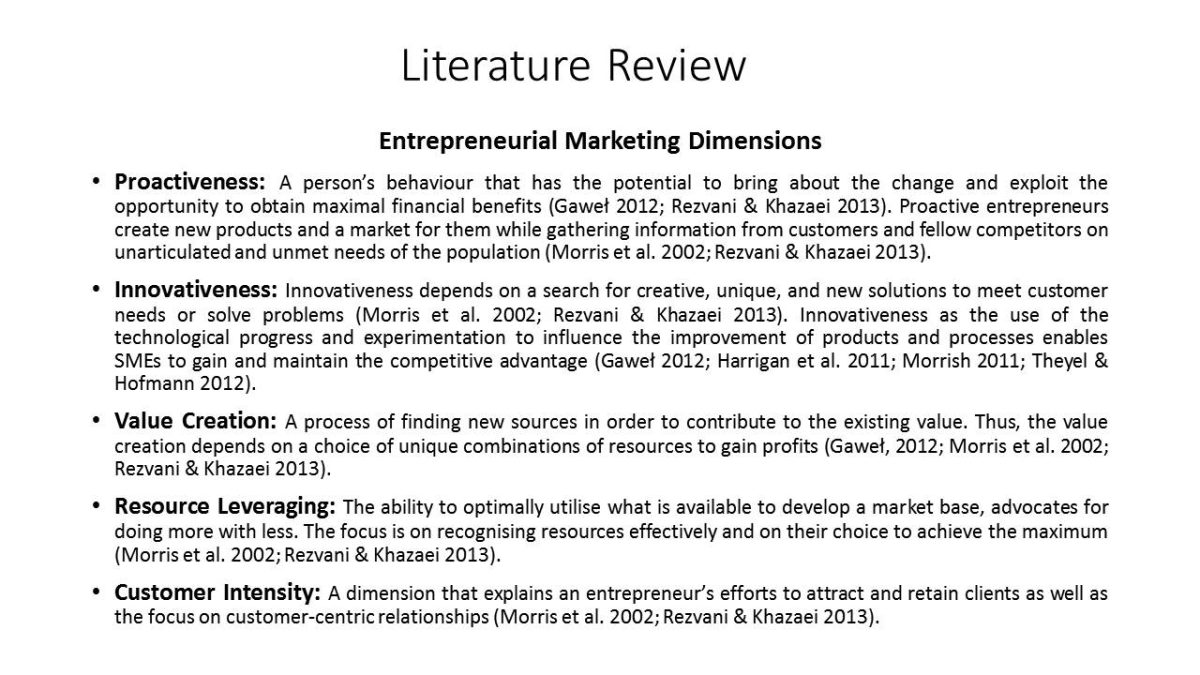
Theoretical Framework
Dimensions of Entrepreneurial Marketing ⇒ Business Sustainability:
- Opportunity Focus;
- Value Creation;
- Risk Calculating;
- Customer Intensity;
- Proactiveness;
- Innovativeness;
- Resource Leveraging.
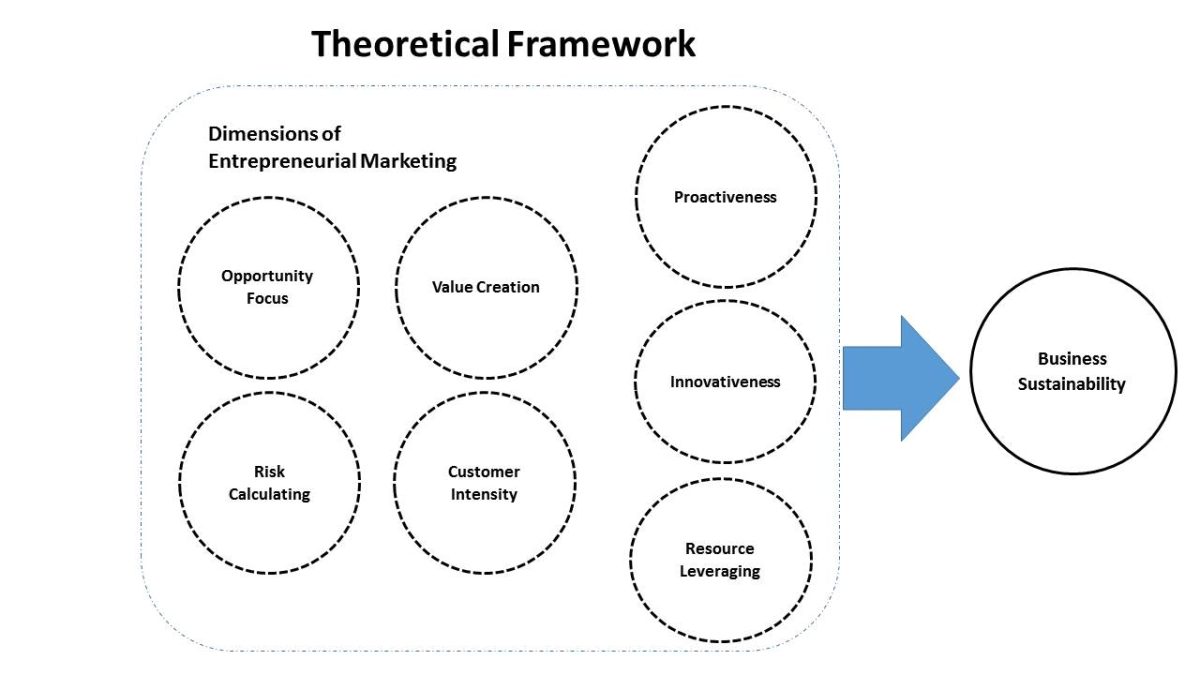
Research Gaps
- In spite of the presence of many qualitative researches on SMEs’ sustainability and aspects, there is a lack of empirical research in the field to discuss social, economic, environmental aspects of sustainability (Arend 2014; Parrish 2010).
- There is insufficient scientific literature on using sustainability practices by SMEs, and how these firms operate to meet environmental and social needs (Guido et al. 2011; Müller & Pfleger 2014).
- Even if researchers mention innovation and proactiveness while discussing sustainability, they do not discuss entrepreneurial marketing dimensions as predictors of sustainability (Avram & Kuhne 2008; Guido et al. 2011; Loucks et al. 2010; Moore & Manring 2009).
- Many of the past studies have focused on SMEs in the Western countries, and there is a limited focus on the other countries, including Saudi Arabia (Avram & Kuhne 2008; Bansal & Clelland 2004).
- There is the lack of research on inter-relationship of entrepreneurial marketing dimensions, and the discussion of the role of entrepreneurial marketing dimensions in developing SMEs’ sustainability is fragmented because researchers mentioned proactiveness, innovation, resource leveraging related to EM only in the context of the SME’s competitive advantage (Avram & Kuhne 2008; Guido et al. 2011; Loucks et al. 2010; Moore & Manring 2009).
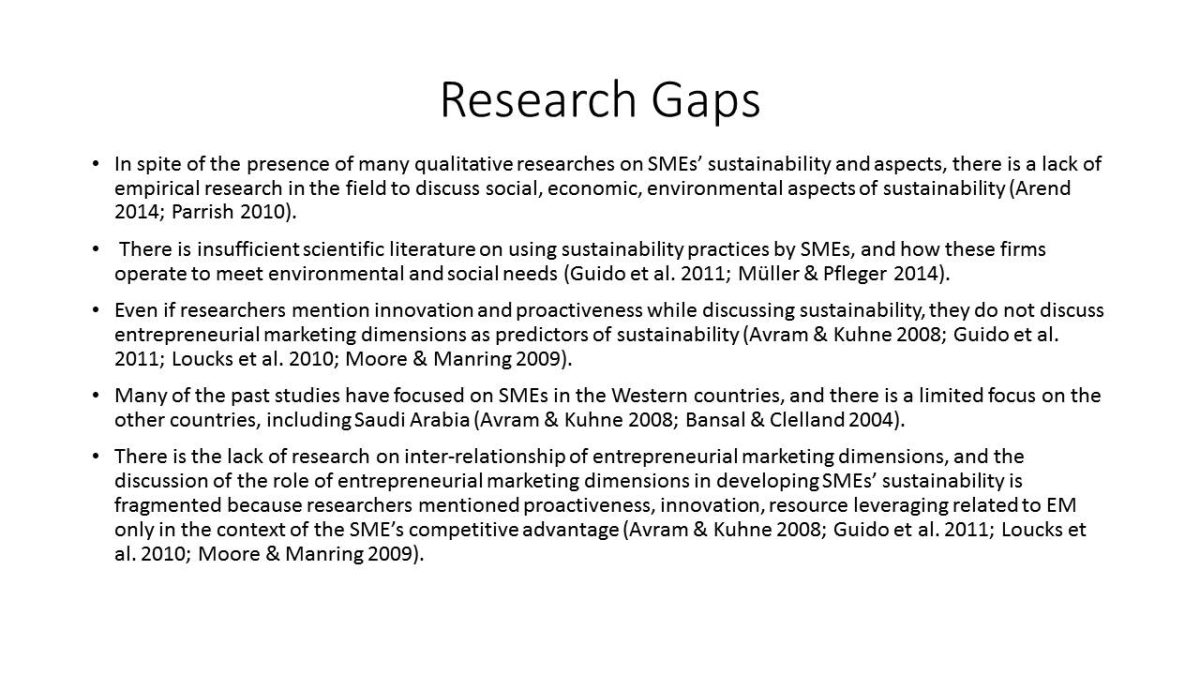
Research Model
Entrepreneurial Marketing
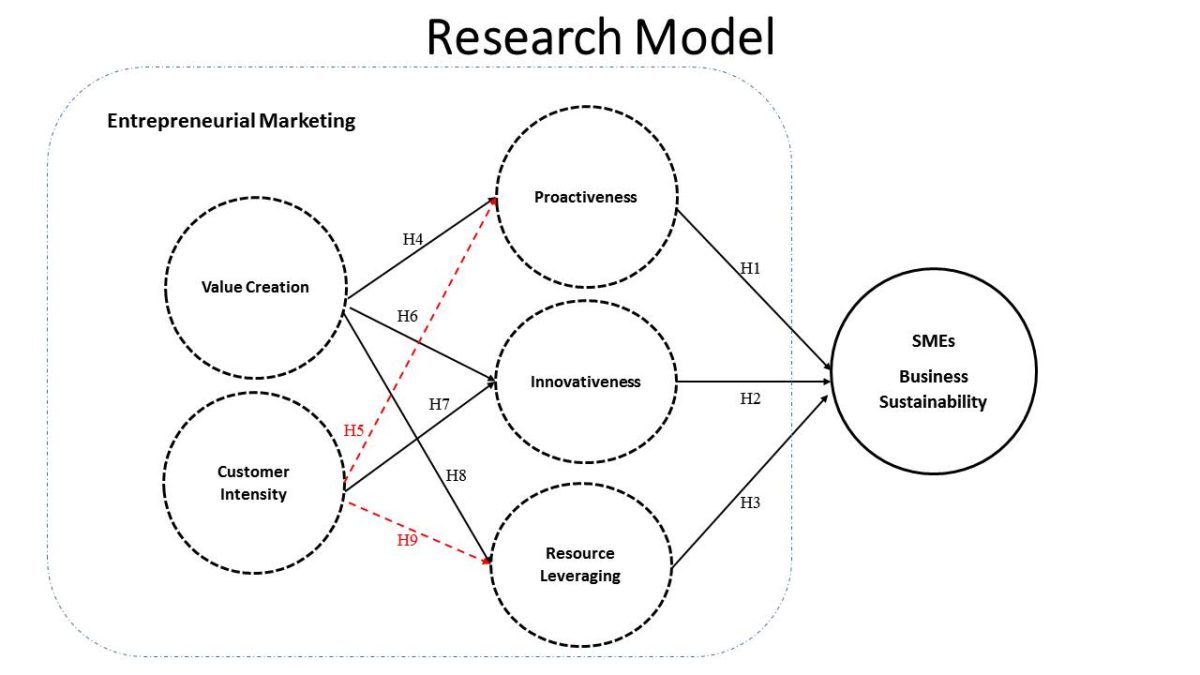
Hypotheses
H1: Proactiveness will have a positive effect on business sustainability of small and medium enterprises.
Proactiveness as an activity aimed at pursuing greater profits can influence sustainability because sustainability is linked to efficiency and equality determined by the economic, social and environmental aspects of a society (Gawel 2012; Morris et al. 2002). Proactiveness entails the decisions, processes and practices within a firm that meet the needs of the larger society. Proactive firm practices result in an increased utilisation of raw materials; thus, reduced operation costs (Mitra et al. 2008; Moore & Manring 2009).
H2: Innovativeness has a positive effect on business sustainability of small and medium enterprises.
Sustainability and survival of firms are based on innovation which is a key element for the economy growth and company’s success (Bresciani et al. 2011; Vanormelingen & Cassiman 2013). Innovation is associated with increased sales and returns that enable a business to reach sustainability by engaging in actives that meet the need of the larger society (Dobni 2010). Innovation as bringing and presenting out new products, services, solutions, and technologies into the marketplace can be helpful in achieving sustainability (Gawel 2012; Hills & Hultman 2011). Continuous innovation in the market is essential for SMEs to sustain and survive (Kickul and Gundry 2002; Morris et al. 2002).
H3: Resource Leveraging has a positive effect on business sustainability of small and medium enterprises.
Both internal and external resources are imperative in enhancing business survivability and sustainability (Wallnofer & Hacklin 2013). Resource leveraging is positively related to sustainability because knowledge, skills, and funds are important for a firm to progressively sustain its innovative environment that is imperative for the business’ survival (Gawel 2012; Rezvani & Khazaei 2013).
H4: Value Creation has a positive effect on Proactiveness practices of small and medium enterprises.
Value creation leads to proactiveness because a firm that is constantly seeking new ways to enhance the value of its products is deemed proactive (Becherer et al. 2008). New marketing strategies that incorporate the 4Es (education, esthetic, entertainment and escapist experience) and support proactiveness are associated with value creation (Fiore et al. 2013).
H5: Customer Intensity has a positive effect on proactiveness practices of small and medium enterprises.
Customer intensity is required in the development of new products and services, and a company can become the pioneer in the market (Gawel 2012; Hacioglu et al. 2012; Morris et al. 2002). Customer intensity takes various forms, and it is related to proactiveness in achieving the ultimate outcomes, innovation and progress (Hacioglu et al. 2012).
H6: Value Creation has a positive effect on innovativeness practices of small and medium enterprises.
Value creation can be obtained through co-opetition (Tanev et al. 2011; Vrontis et al. 2012). Value creation is closely associated with collaborative innovation because of the need to focus on principles of interactivity and flexibility in the organisation’s development (Sawhney et al. 2005). The focus on the value creation is the guarantee to promote innovation in the company (Bowonder et al. 2010). Only those organisations that are value creators can be discussed as innovative organizations because the value creation is the necessary condition to achieve innovation in the field of marketing (Dobni 2010).
H7: Customer Intensity has a positive effect on innovativeness practices of small and medium enterprises.
Customer intensity continues to increase as more social networks are created; and in these networks, customers freely give their views about particular products and services. This process is associated with innovation and the active use of the Internet in business and marketing (Hacioglu et al. 2012; Kickul & Gundry 2002; Morris et al. 2002; Sawhney et al. 2005).
H8: Value Creation has a positive effect on resource leveraging practices of small and medium enterprises.
There is a positive correlation between value creation and resource leveraging because in every business venture, there is always the use of resources so that value can be created from the product or service that these resources generate (Chen et al. 2008; Sull & Escobari 2004). Firms can succeed in the market by forming their own resources that help them to create value (Kraus & Britzelmaier 2012; Kurgun et al. 2011).
H9: Customer Intensity has a positive effect on resource leveraging practices of small and medium enterprises.
Customer involvement is a resource that drives a firm towards innovation. Customer intensity has a positive relationship with resource leveraging. Businesses are able to succeed by building strong relationships with their clients, and thereby, leveraging resources (Lahtinen 2013; Sawhney et al. 2005).
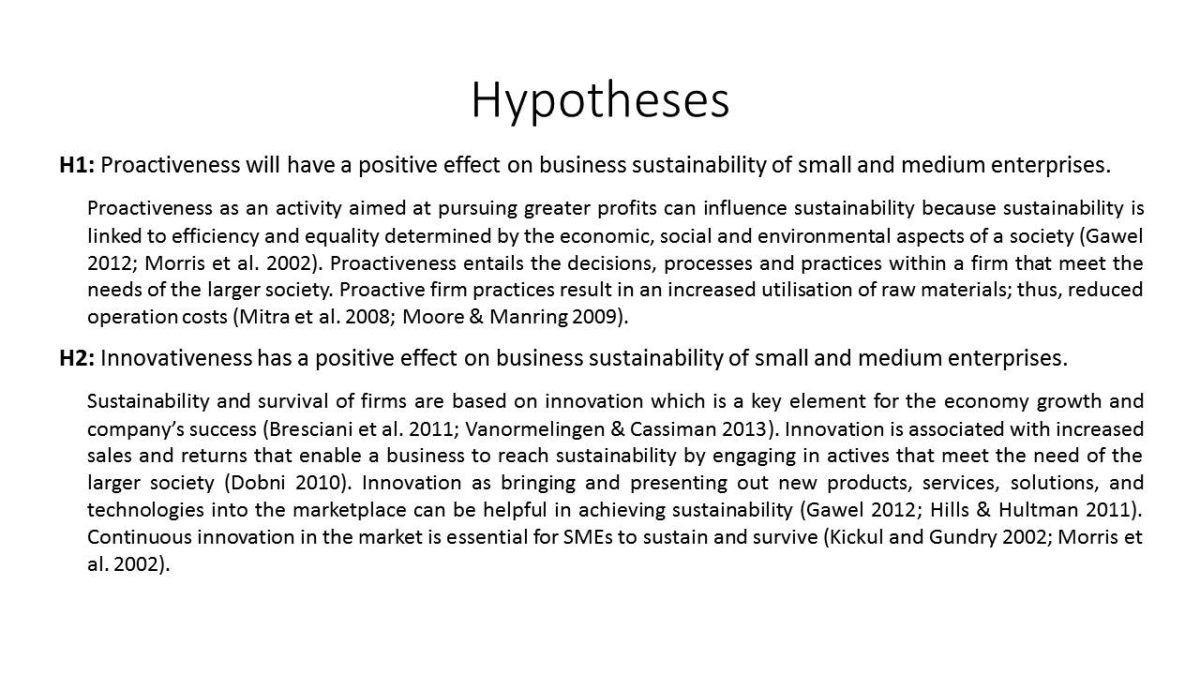
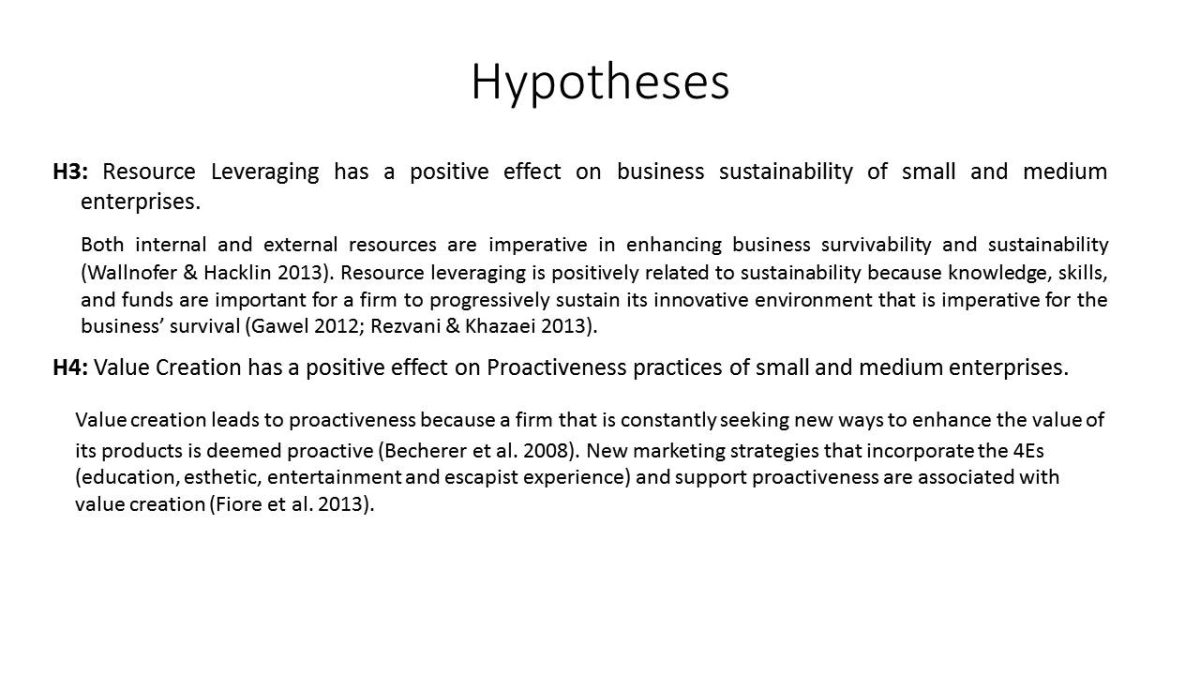
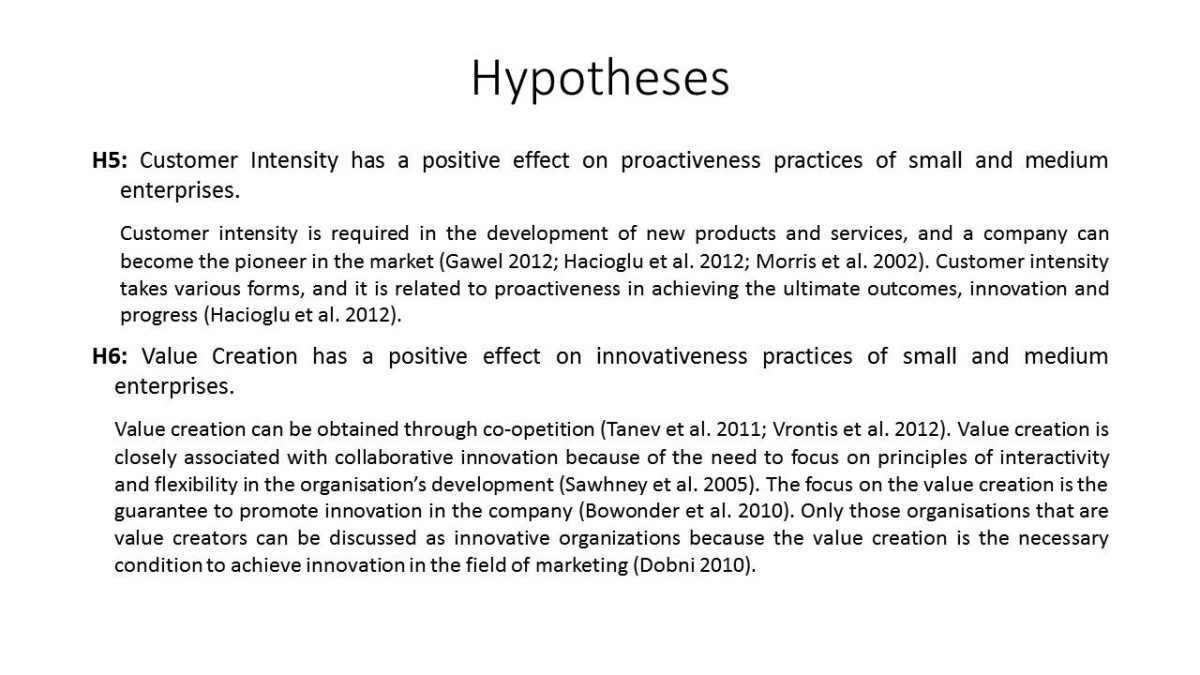
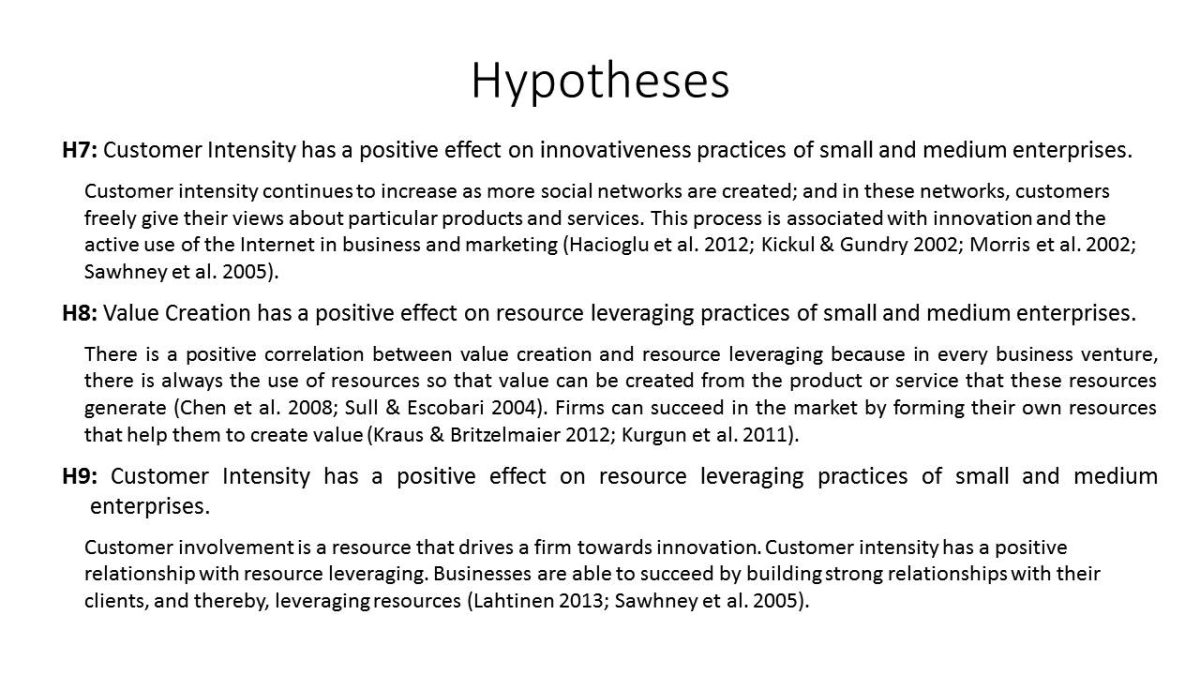
Research Methodology
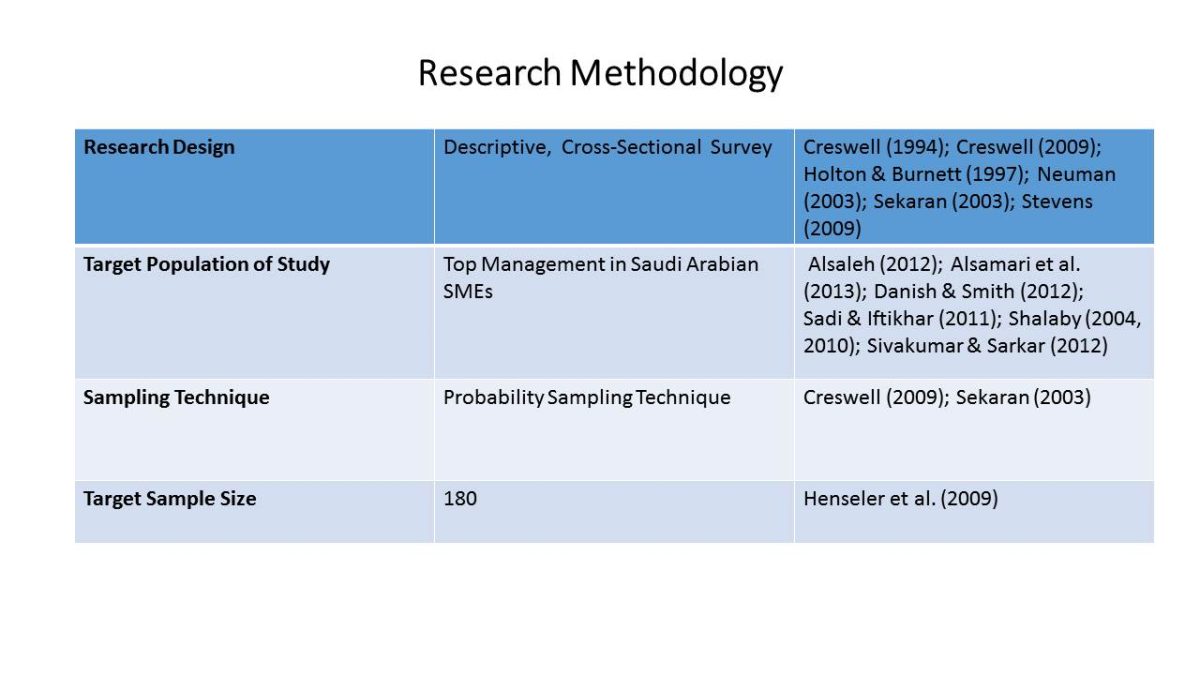
Research Procedure
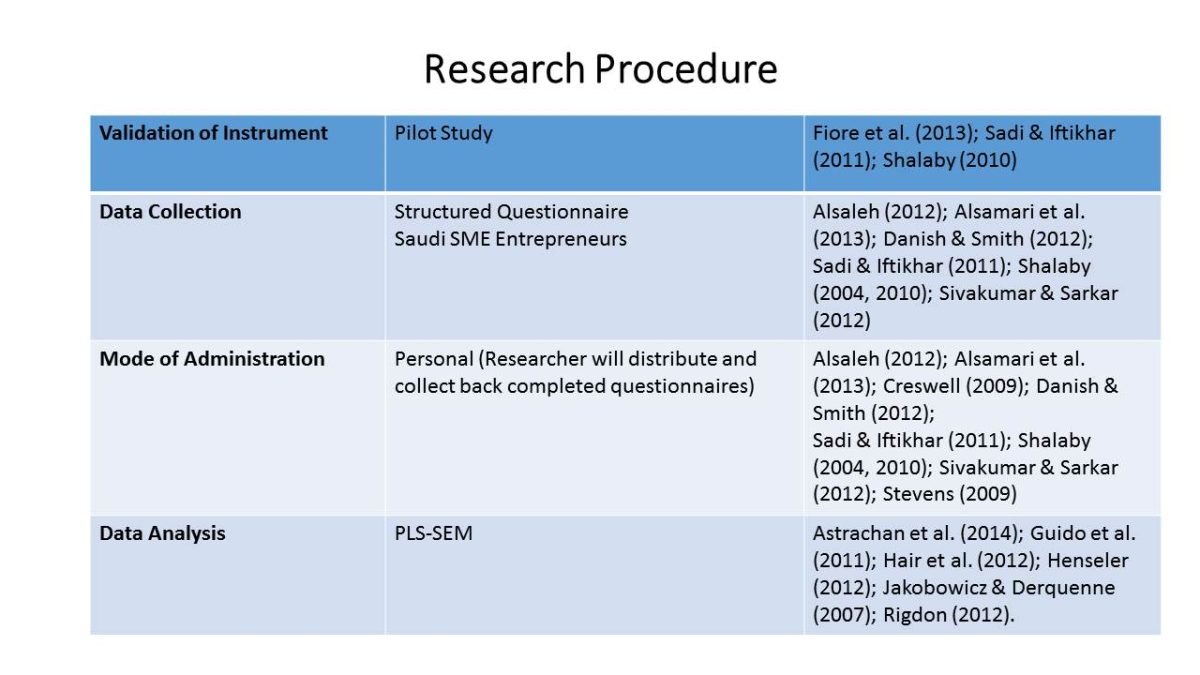
References
Alsaleh, A. 2012. Exploring Strategies for Small and Medium Enterprises in Saudi Arabia. RIBM Doctoral Symposium 3(1): 1-13.
Ahrholdt, D. C. 2011. Empirical Identification of Success-Enhancing Website Signals in E-Tailing: An Analysis Based on Known E-Tailers and the Theory of Reasoned Action. Journal of Marketing Theory and Practice 19(4): 441–458.
Al-Jasser, M. 2011. Small and Medium Enterprises. London: Institute of Banking.
Allurentis Limited. 2013. Saudi Arabia 2013-2014: Discovering Business. London: Allurentis Limited.
Alsamari, A., Slade, H., Sharif, M. & Saleh, W. 2013. The SMEs Challenges and Opportunities in Bahrain and Saudi Arabia. International Journal of Computer Networks and Wireless Communications 3(2): 107-118.
Amoah-Manseh, A. 2013. Strategic Resources and Performance of Rural SMEs. International Journal of Business and Social Research 3(4): 106-119.
Arend, R. J. 2014. Social and Environmental Performance at SMEs: Considering Motivations, Capabilities, and Instrumentalism. Journal of Business Ethics 1(2): 1-21.
Asif, M., Searcy, C., Zutshi, A. & Ahmad, N. 2011. An Integrated Management Systems Approach to Corporate Sustainability. European Business Review 23(4): 353-367.
Astrachan, C. B., Patel, V. K. & Wanzenried, C. 2014. A Comparative Study of CB-SEM and PLS-SEM for Theory Development in Family Firm Research. Journal of Family Business Strategy 5(1): 116–128.
Avram, D. O. & Kuhne, S. 2008. Implementing Responsible Business Behaviour from a Strategic Management Perspective: Developing a Framework for Austrian SMEs. Journal of Business Ethics 82(1): 463–475.
Bansal, P. & Clelland, I. 2004. Talking Trash: Legitimacy, Impression Management, and Unsystematic Risk in the Context of the Natural Environment. Academy of Management Journal 47(1): 93-103.
Becherer, R. C., Haynes, P. J. & Helms, M. M. 2008. An Exploratory Investigation of Entrepreneurial Marketing in SMEs: The Influence of the Owner/Operator. Journal of Business and Entrepreneurship 20(2): 44-63.
Berghman, L., Matthyssens, P., Streukensand, S. & Vandenbempt, K. 2013. Deliberate Learning Mechanisms for Stimulating Strategic Innovation Capacity. Long Range Planning 46(1): 39–71.
Bowonder, B., Dambal, A., Kumar, S. & Shirodkar, A. 2010. Innovation Strategies for Creating Competitive Advantage. Research-Technology Management 53(3): 19-32.
Bresciani, S., Thrassou, A. & Vrontis, D. 2011. The Link between Family Business and Innovation: Evidence from an Italian Sample. Business Research Challenges in a Turbulent Era 2(10): 290-307.
Brilius, P. 2010. Economic Crisis and SMEs Sustainability Policies: Application of Emotional Well-Being Function for Analysis. Journal of Advanced Research in Management 1(1): 18-29.
Brunton, D. & Ahlstrom, D. 2010. Institutional Theory and Entrepreneurship: Where Are We Now and Where Do We Need to Move in the Future? ETP 5(2): 421–440.
Burns, T. & Stalker, G. M. 1961. The Management of Innovation. London: Tavistock.
Buttermann, G., Germaina, R. & Iyer, K. 2008. Contingency Theory “Fit” as Gestalt: An Application to Supply Chain Management. Transportation Research Part E: Logistics and Transportation Review 44(6): 955-69.
Chen, L.-J., Chen, C.-C. & Lee, W.-R. 2008. Strategic Capabilities, Innovation Intensity, and Performance of Service Firms. Journal of Service Science and Management 1(1): 111–122.
Creswell, J. W. 1994. Research Design. Thousand Oaks: Sage Publications.
Creswell, J. W. 2009. Research Design: Qualitative, Quantitative, and Mixed Methods Approaches. Los Angeles: Sage Publications.
Danish, A. Y. & Smith, H. L. 2012. Female Entrepreneurship in Saudi Arabia: Opportunities and Challenges. International Journal of Gender and Entrepreneurship 4(3): 216-235.
Delmas, M. 2002. The Diffusion of Environmental Management Standards in Europe and the United States: An Institutional Perspective. Policy Sciences 35(1): 91–119.
DiMaggio, P.J. & Powell, W.W. 1983. The Iron Cage Revisited: Institutional Isomorphism and Collective Rationality in Organizational Fields. American Sociological Review 48(1): 147–160.
Dobni, C. B. 2010. Achieving Synergy between Strategy and Innovation: The Key to Value Creation. International Journal of Business Science & Applied Management 5(1): 48-58.
Dyer, L. M., & Ross, C. A. 2008. Seeking advice in a dynamic and complex business environment: Impact on the success of small firms. Journal of Developmental Entrepreneurship, 13(02): 133-149.
Fiore, A., Nehm, L., Hurst, J., Son, J. & Sadachar, A. 2013. Entrepreneurial Marketing: Scale Validation with Small, Independently-Owned Businesses. Journal of Marketing and Development and Competitiveness 7(4): 63-86.
Franco, M., Santos, M., Ramalho, I. & Nunes, C. 2014. An Exploratory Study of Entrepreneurial Marketing in SMEs: The Role of the Founder-Entrepreneur. Journal of Small Business and Enterprise Development 21(2): 265-283.
Gaweł, A. 2012. Entrepreneurship and Sustainability: Do They Have Anything in Common? Poznan University of Economics Review 12(1): 5-16.
Gilmore, A., Carson, D. & Grant, K. 2001. SME Marketing in Practice. Marketing Intelligence and Planning 19(1): 6–11.
Gladwin, T. 2010. Shifting Paradigms for Sustainable Development: Implications for Management Theory and Research. Academy of Management Review 20(2): 874-907.
Glover, J., Champion, D., Daniels, K. & Dainty, A. 2014. An Institutional Theory Perspective on sustainable Practices across the Dairy Supply Chain. International Journal of Production Economics 152(2): 102–111.
Guido, G., Marcati, A. & Peluso, A. 2011. Nature and Antecedents of a Marketing Approach according to Italian SME Entrepreneurs: A Structural Equation Modeling Approach. International Journal of Entrepreneurial Behaviour & Research 17(4): 342-360.
Hacioglu, G., Eren, S. S., Eren, M. S. & Celikkan, H. 2012. The Effect of Entrepreneurial Marketing on Firms’ Innovative Performance in Turkish SMEs. Procedia-Social and Behavioral Sciences 58(2): 871-878.
Hair, J. E., Starstedt, M., Pieper, T. M. & Ringe, C. M. 2012. The Use of Partial Least Squares Structural Equation Modeling in Strategic Management Research: A Review of Past Practices and Recommendations for Future Applications. Long Range Planning 45(4): 320–340.
Hall, J. K., Daneke, G. A. & Lenox, M. J. 2010. Sustainable Development and Entrepreneurship: Past Contributions and Future Directions. Journal of Business Venturing 25(5): 439-448.
Han, L., Benson, A., Chen, J. & Zhang, S. 2014. The Use and Impacts of Bank Support on UK Small and Medium-Sized Enterprises. International Small Business Journal 32(1): 61-80.
Harrigan, P., Ramsey, E. & Ibbotson, P. 2011. Entrepreneurial Marketing in SMEs: The Key Capabilities of E-CRM. Journal of Research in Marketing and Entrepreneurship 14(1): 40-64.
Henseler, J., Ringle, C. M. & Sinkovics, R. R. 2009. The Use of Partial Least Squares Path Modeling in International Marketing. New Challenges to International Marketing Advances in International Marketing 20(3): 277–319.
Hertog, S. 2010. Benchmarking SME Policies in the GCC: A Survey of Challenges and Opportunities. Brussels: Eurochambres.
Hills, G. & Hultman, C. M. 2011. Academic Roots: The Past and Present of Entrepreneurial Marketing. Journal of Small Business & Entrepreneurship 24(1): 1-10.
Hills, G., Hultman, C. M. & Miles, P. 2008. The Evolution and Development of Entrepreneurial Marketing. Journal of Small Business Management 46(1): 103-104.
Holton, E. H. & Burnett, M. B. 1997. “Qualitative Research Methods”. In Human Resource Development Research Handbook: Linking Research and Practice, eds. R. A. Swanson and E. F. Holton. San Francisco: Berrett-Koehler Publishers.
Ionita, D. 2012. Entrepreneurial Marketing: A New Approach for Challenging Times. Management & Marketing 7(1): 131-135.
Jakobowicz, E. & Derquenne, C. 2007. A Modified PLS Path Modeling Algorithm Handling Reflective Categorical Variables and a New Model Building Strategy. Computational Statistics & Data Analysis 51(2): 3666–3678.
Kesper, A. 2001. Failing or not Aiming to Grow? Manufacturing SMMEs and Their Contribution to Employment Growth in South Africa. Urban Forum 12(2): 171-203.
Ketokivi, J. 2006. Elaborating the Contingency Theory or Organisations: The Case of Manufacturing Flexibility Strategies. Production and Operations Management 15(2): 215-228.
Kickul, J. & Gundry, L. 2002. Prospecting for Strategic Advantage: The Proactive Entrepreneurial Personality and Small Firm Innovation. Journal of Small Business Management 40(2): 85-97.
Kongolo, M. 2010. Job Creation versus Job Shedding and the Role of SMEs in Economic Development. African Journal of Business Management 4(11): 2288-2295.
Kraus, S., Harms, R. & Fink, M. 2010. Entrepreneurial Marketing: Moving beyond Marketing in New Ventures. Entrepreneurship and Innovation Management 11(1): 19-34.
Kurgun, H., Bagiran, D., Ozeren, E. & Maral, B. 2011. Entrepreneurial Marketing – The Interface between Marketing and Entrepreneurship: A Qualitative Research on Boutique Hotels. European Journal of Social Sciences 26(3): 340-357.
Lahtinen, J. 2013. SME View on Project Marketing-Case Study in the Context of Institutional Space Business. Helsinki: Aalto University.
Lawrence, S., Collins, E., Pavlovich, K. & Arunachalam, M. 2006. Sustainability Practices of SMEs: The Case of NZ. Business Strategy and the Environment 15(4): 242-257.
Lawrence, P.R. & Lorsch, J.W. 1967. Organization and Environment: Managing Differentiation and Integration. Boston, MA: Harvard University.
Loucks, E. S., Martens, M. L. & Cho, C. H. 2010. Engaging Small-And Medium-Sized Businesses in Sustainability. Sustainability Accounting, Management and Policy Journal 1(2): 178-200.
Masurel, E. 2007. Why SMEs Invest in Environmental Measures: Sustainability Evidence from Small and Medium-Sized Printing Firms. Business Strategy and the Environment 16(3): 190-201.
McAdam, R. 2000. The Implementation of Reengineering in SMEs: A Grounded Study. Small Business Journal 18(1): 29-45.
Meyer, J. W. & Scott, W. R. 1983. Organizational Environments: Ritual and Rationality. Beverly Hills, CA: Sage Publications.
Mitra, S., Dhar, S. & Agrawal, K. M. 2008. Assessment of Corporate Environmental Proactiveness. South Asian Journal of Management 15(3): 101-135.
Moore, S. & Manring, S. 2009. Strategy Development in Small and Medium Sized Enterprises for Sustainability and Increased Value Creation. Journal of Cleaner Production 17(1): 276-282.
Morris, M. H. Schindehutte, M. & LaForge, R. W. 2002. Entrepreneurial Marketing: A Construct for Integrating Emerging Entrepreneurship and Marketing Perspectives. Journal of Marketing Theory and Practice 10(4): 1–19.
Morrish, S. 2011. Entrepreneurial Marketing: A Strategy for the Twenty-First Century? Journal of Research in Marketing and Entrepreneurship 13(2): 110-119.
Müller, A. L. & Pfleger, R. 2014. Business Transformation towards Sustainability. Business Research 7(2): 313-350.
Nasr, S., & Rostom, A. 2013. SME Contributions to Employment, Job Creation, and Growth In The Arab World. Washington: World Bank.
Neuman, W. L. 2003. Social Research Methods: Qualitative and Quantitative. New York: Pearson Education Inc.
OECD. 2009. The Impact of the Global Crisis on SME and Entrepreneurship Financing and policy Responses. Paris: OECD Publishing.
Parrish, B. D. 2010. Sustainability-Driven Entrepreneurship: Principles of Organization Design. Journal of Business Venturing 25(5): 510-523.
Ramachandran, J., Mukherji, S. & Sud, M. 2006. Strategic Entrepreneurship in a Globalising Economy: Evidence from Emerging Economies. IIMB Management Review 28(3): 291-302.
Rezvani, M. & Khazaei, M. 2013. Evaluation of Entrepreneurial Marketing Dimensions According to Characteristics of Institutions: Institutions Age and Size. International Journal of Basic Sciences & Applied Research 3(4): 207-213.
Rigdon, E. E. 2012. Rethinking Partial Least Squares Path Modeling: In Praise of Simple Methods. Long Range Planning 45(2): 314–358.
Rivera, J. 2004. Institutional Pressures and Voluntary Environmental Behavior in Developing Countries: Evidence from the Costa Rican Hotel Industry. Social Natural Resources 17(2): 779–797.
Riyadh Chamber Commerce & Industry. 2011. Small and Medium Enterprises in Saudi Arabia. Saudi Arabia: RCCI Publishing.
Rocha, R., Subika, F., Khouri, R. & Pearce, D. 2011. The status of bank lending to SMEs in the Middle East and North Africa region: Results of a joint survey of the Union of Arab Bank and the World Bank. Washington: World Bank.
Sadi, M. A. & Iftikhar, Q. 2011. Factors Critical to the Success of Small-Medium Sized Business Marketing: A View from the Tourism Industry in Saudi Arabia. African Journal of Marketing Management 3(9): 226-232.
Saudi-US Relation Information Service. 2011. Boosting Small and Medium Enterprises in Saudi Arabia. Saudi Arabia: SUSRIS.
Sawhney, M., Verona, G. & Prandelli, E. 2005. Collaborating to Create: The Internet as a Platform for Customer Engagement in Product Innovation. Journal of interactive marketing 19(4): 4-17.
Sekaran, U. 2003. Research Methods for Business. Hoboken: John Wiley and Sons.
Shalaby, N. 2004. SMEs Developments Saudi Arabia. Dammam: Eastern Province Chamber of Commerce and Industry Publishing.
Shalaby, N. 2010. SMEs Capabilities and Needs Assessment Eastern Province, Saudi Arabia. Saudi Arabia: Eastern Province Chamber of Commerce and Industry.
Sharma, G. 2011. Do SMEs Need to Strategize? Business Strategy Series 12(4): 186-194.
Simpson, M., Taylor, N. & Barker, K. 2004. Environmental Responsibility in SMEs: Does It Deliver Competitive Advantage? Business Strategy and the Environment 13(3): 156-171.
Sivakumar, A. D. & Sarkar, S. 2012. Women Entrepreneurs in Small and Medium Scale Businesses in Saudi Arabia. International Journal of Finance & Policy Analysis 4(1): 25-38.
Starik, M. & Kanashiro, P. 2013. Toward a Theory of Sustainability Management: Uncovering and Integrating the Nearly Obvious. Organization & Environment 26(1): 7-30.
Stefanović, I., Prokic, S. & Rankovic, L. 2010. Motivational and Success Factors of Entrepreneurs: The Evidence from a Developing Country. Journal of Economics and Business 28(2): 251-269.
Stevens, C. 2009. Measuring Sustainable Development. Paris: OECD Publishing.
Sull, D. & Escobari, M. 2004. Creating Value in an Unpredictable World. Business Strategy Review 15(3): 14–20.
Tambunan, T. 2008. SME development, economic growth, and government intervention in a developing country: The Indonesian story. Journal of International Entrepreneurship 6(4): 147-167.
Tanev, S., Bailetti, T., Allen, S., Milyakov, H., Durchev, P. & Ruskov, P. 2011. How Do Value Co-Creation Activities Relate to the Perception of Firms’ Innovativeness? Journal of Innovation Economics & Management 1(7): 131-153.
Theyel, G. & Hofmann, K. 2012. Stakeholder Relations and Sustainability Practices of US Small and Medium-Sized Manufacturers. Management Research Review 35(12): 1110-1133.
Vanormelingen, S. & Cassiman, B. 2013. Profiting from Innovation: Firm Level Evidence on Markups. Flanders: KU Leuven.
Vrontis, D., Thrassou, A., Chebbi, H. & Yahiaoui, D. 2012. Transcending Innovativeness towards Strategic Reflexivity. Qualitative Market Research: An International Journal 15(4): 420-437.
Wallnofer, M. & Hacklin, F. 2013. The Business Model in Entrepreneurial Marketing: A Communication Perspective on Business Angels’ Opportunity Interpretation. Industrial Marketing Management 42(5): 755–764.
Webb, J. W., Ireland, R. D., Hitt, M. A., Kistruck, G. M. & Tihanyi, L. 2011. Where Is the Opportunity without the Customer? An Integration of Marketing Activities, the Entrepreneurship Process, and Institutional Theory. Journal of the Academy of Marketing Science 39(4): 537-554.
Welcomer, S. 2011. Reinventing vs. Restoring Sustainability in the Maine Woods: Narratives of Progress and Decline 2010. Organization & Environment 23(2): 55-75.
Wu, G., Ding, J. & Chen, P. 2012. The Effects of GSCM Drivers and Institutional Pressures on GSCM Practices in Taiwan’s Textile and Apparel Industry. IJPE 135(2): 618–636.